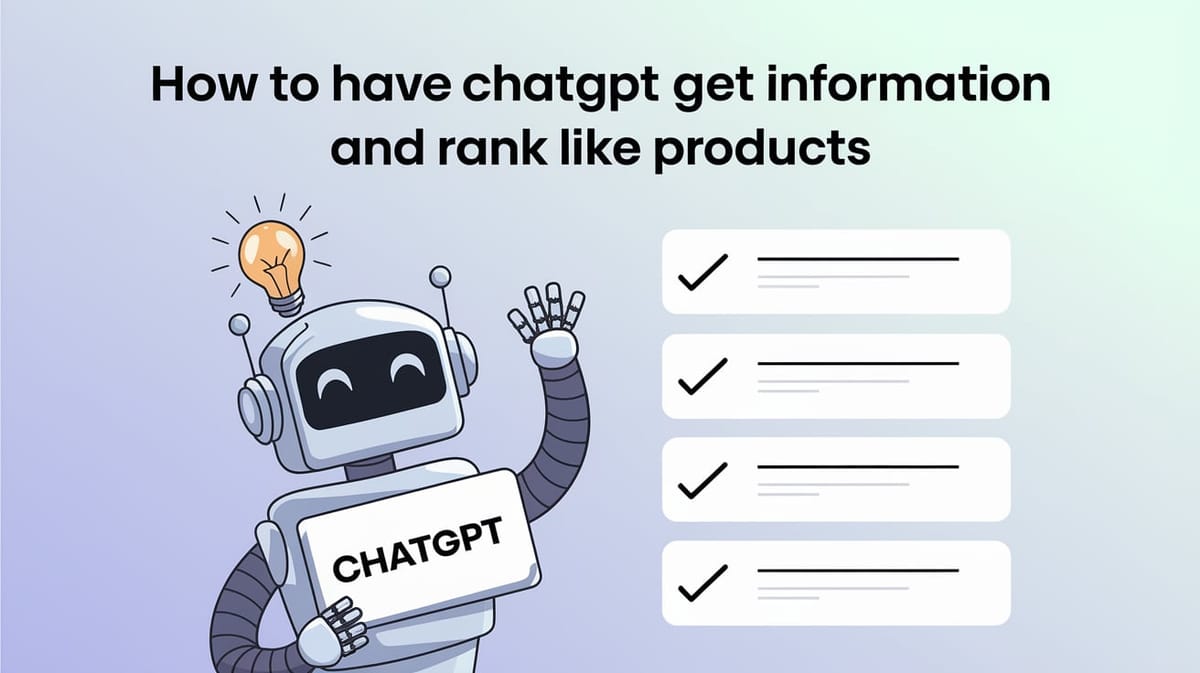How to have ChatGPT get information and rank like products

In the rapidly evolving landscape of artificial intelligence, tools like ChatGPT have become invaluable for businesses seeking to streamline processes such as product comparison and competitor analysis. This report delves into the methodologies for utilizing ChatGPT to gather information and rank similar products effectively. By leveraging AI capabilities, businesses can enhance their decision-making processes, ensuring they remain competitive in their respective markets.
Understanding ChatGPT's Capabilities
ChatGPT, particularly in its GPT-4 iteration, is designed to process and analyze large volumes of data, making it an ideal tool for creating product comparison matrices and conducting competitor analysis. The AI can generate detailed insights by synthesizing information from various sources, thus providing a comprehensive overview of product features, strengths, and weaknesses.
You can also visit Oncely.com to find more Top Trending AI Tools. Oncely partners with software developers and companies to present exclusive deals on their products. One unique aspect of Oncely is its “Lifetime Access” feature, where customers can purchase a product once and gain ongoing access to it without any recurring fees. Oncely also provides a 60-day money-back guarantee on most purchases, allowing customers to try out the products and services risk-free.
Oncely are hunting for the most fantastic AI & Software lifetime deals like the ones below or their alternatives:

Product Comparison Matrix
A product comparison matrix is a structured tool that allows businesses to evaluate and compare different products based on specific criteria. ChatGPT can assist in creating these matrices by using tailored prompts that guide the AI to focus on relevant product attributes. The process involves several steps:
- Accessing the Prompt: Users begin by accessing a predefined prompt designed for product comparison. This prompt is available on platforms like AI for Work, which provides a step-by-step guide on utilizing ChatGPT for this purpose.
- Inputting Product Information: Users input specific product details into the ChatGPT interface. The AI then processes this information, comparing it against its extensive knowledge base to generate a matrix that highlights key product features and differences.
- Customization and Evaluation: ChatGPT offers options to further personalize the matrix by answering additional questions or simulating feedback from focus groups. This ensures that the final output is tailored to the user's specific needs and meets high-quality standards.
Competitor Analysis
In addition to product comparison, ChatGPT is also adept at conducting competitor analysis. This involves gathering and analyzing data about competitors to identify their strengths, weaknesses, and market strategies. The process is facilitated by specific prompts that guide the AI in extracting relevant insights from vast data sources.
- Identifying Key Competitors: ChatGPT can quickly identify key competitors in a given industry by analyzing market data and trends. This is crucial for businesses looking to position themselves strategically in the market.
- Analyzing Competitor Strategies: The AI can delve into competitors' business strategies, including their product offerings, marketing tactics, and customer engagement practices. This information is vital for businesses aiming to refine their strategies and gain a competitive edge.
- Generating Insights: By synthesizing data from various sources, ChatGPT provides actionable insights that businesses can use to enhance their market position. This includes identifying gaps in the market and potential areas for innovation.
Methodology for Ranking Products
Ranking products involves evaluating them based on specific criteria and assigning a score or rank to each product. ChatGPT can facilitate this process by:
- Defining Evaluation Criteria: Users can define the criteria for evaluation, such as price, features, user reviews, and brand reputation. ChatGPT uses these criteria to assess each product's performance.
- Data Collection and Analysis: The AI collects data from various sources, including product specifications, customer reviews, and expert opinions. It then analyzes this data to determine how each product ranks against the defined criteria.
- Generating a Ranking Report: ChatGPT compiles the analysis into a comprehensive report that ranks the products based on their overall performance. This report can be used by businesses to make informed purchasing or marketing decisions.
Case Study: Using ChatGPT for Recommendations
A case study conducted by researchers at Hong Kong Baptist University demonstrated ChatGPT's ability to provide personalized recommendations across multiple product domains. The study highlighted the AI's capability to adapt to user preferences and provide context-aware recommendations, further showcasing its potential in product ranking and comparison tasks.
Conclusion
ChatGPT offers a powerful tool for businesses looking to gather information and rank similar products. By leveraging its capabilities, businesses can create detailed product comparison matrices, conduct thorough competitor analysis, and generate insightful product rankings. This not only enhances decision-making processes but also ensures that businesses remain competitive in an ever-evolving market landscape.





